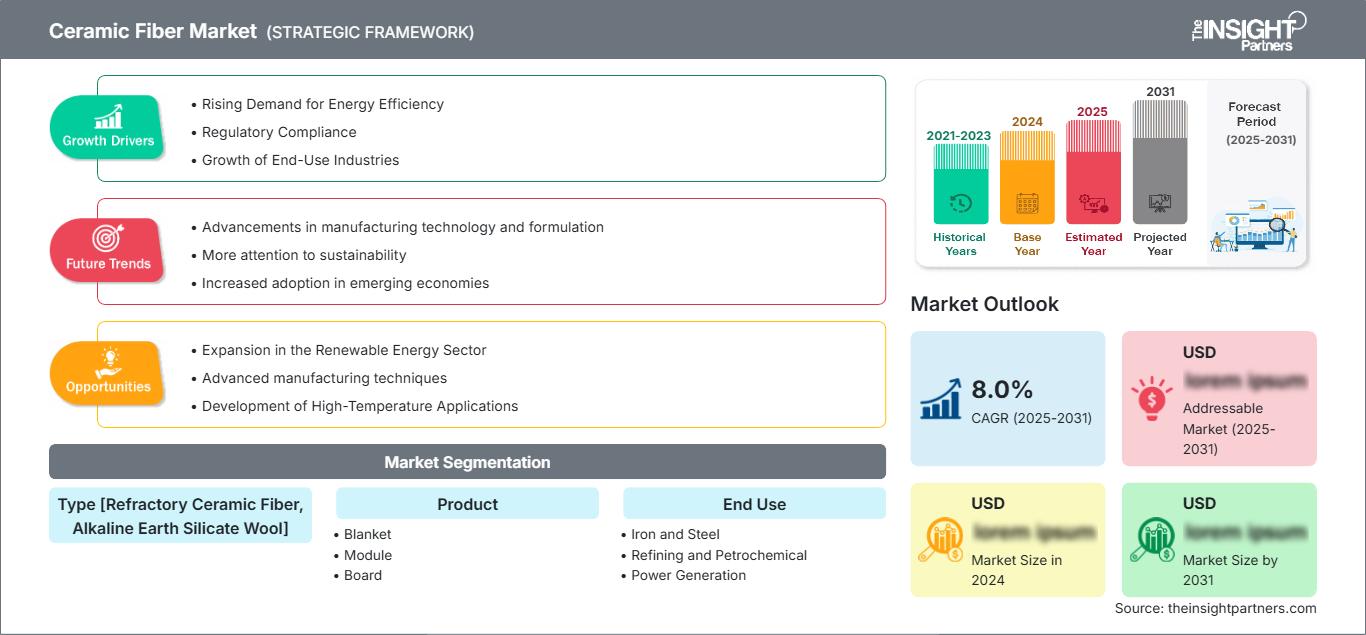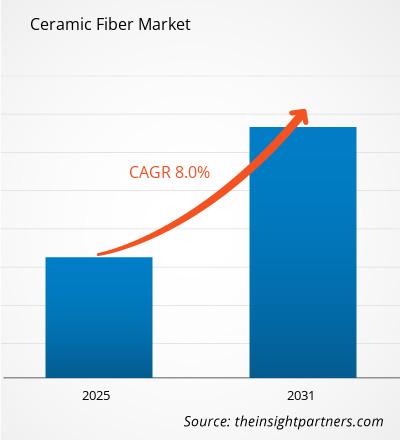Le marché des fibres céramiques devrait atteindre 3,12 milliards de dollars américains d'ici 2031. Ce marché devrait enregistrer un TCAC de 8,9 % entre 2025 et 2031.
Le marché des fibres céramiques est segmenté par type, produit et utilisation finale. Selon le type, il se divise en fibres céramiques réfractaires, laine de silicate alcalino-terreux et autres. Selon le produit, il se segmente en couvertures, modules, panneaux, papier et autres. Selon l'utilisation finale, il se segmente en sidérurgie, raffinage et pétrochimie, production d'énergie, aluminium et autres. Le rapport couvre cinq régions : Amérique du Nord, Europe, Asie-Pacifique, Moyen-Orient et Afrique, et Amérique du Sud et centrale, ainsi que les principaux pays de chaque région. L'analyse globale est ensuite détaillée au niveau régional et par grands pays. Le rapport présente les valeurs en dollars américains pour l'analyse et les segments mentionnés ci-dessus.
Objectif du rapport
Le rapport « Marché des fibres céramiques » de The Insight Partners vise à décrire le contexte actuel et la croissance future, les principaux facteurs de croissance, les défis et les opportunités. Il fournira des informations précieuses à divers acteurs du secteur, tels que :
- Fournisseurs de technologies/Fabricants : Pour comprendre l’évolution de la dynamique du marché et connaître les opportunités de croissance potentielles, afin de prendre des décisions stratégiques éclairées.
- Investisseurs : Réaliser une analyse complète des tendances concernant le taux de croissance du marché, les projections financières du marché et les opportunités existantes tout au long de la chaîne de valeur.
- Organismes de réglementation : Réglementer les politiques et les activités de police sur le marché afin de minimiser les abus, de préserver la confiance des investisseurs et de maintenir l’intégrité et la stabilité du marché.
Segmentation du marché des fibres céramiques : [Fibres céramiques réfractaires, laine de silicate alcalino-terreux]
Produit
- Couverture
- Module
- Conseil
- Papier]
Utilisation finale
- Fer et acier
- Raffinage et pétrochimie
- Production d'énergie
- Aluminium]
Géographie
- Amérique du Nord
- Europe
- Asie-Pacifique
- Amérique du Sud et centrale
- Moyen-Orient et Afrique
Vous bénéficierez d'une personnalisation gratuite de tous les rapports, y compris certaines parties de ce rapport, l'analyse par pays, le pack de données Excel, et vous profiterez également d'offres et de réductions exceptionnelles pour les start-ups et les universités.
Marché des fibres céramiques : Perspectives stratégiques

-
Découvrez les principales tendances du marché présentées dans ce rapport.Cet échantillon GRATUIT comprendra une analyse de données, allant des tendances du marché aux estimations et prévisions.
Facteurs de croissance du marché des fibres céramiques
- Demande croissante d'efficacité énergétique : La demande croissante d'efficacité énergétique renforce considérablement le rôle des fibres céramiques, notamment dans les industries où l'isolation thermique est essentielle. Face aux préoccupations grandissantes concernant les coûts énergétiques dans la production d'électricité, la fabrication et d'autres secteurs industriels, les fibres céramiques sont de plus en plus reconnues comme des solutions permettant de minimiser les pertes de chaleur, de réduire la consommation d'énergie et d'améliorer les performances des systèmes. Ces fibres offrent d'excellentes propriétés d'isolation thermique et, grâce à leur utilisation, les industries peuvent réduire leurs coûts énergétiques et leur empreinte carbone. Avec le renforcement des objectifs de développement durable et la recherche d'une meilleure efficacité énergétique, les entreprises se tournent vers les fibres céramiques comme une solution idéale pour réaliser des économies à long terme et des bénéfices environnementaux.
- Conformité réglementaire : Les nouvelles réglementations environnementales et d’émissions, plus strictes, contraignent les industries à utiliser des matériaux de pointe tels que les fibres céramiques. Non seulement ces matériaux sont écologiques, mais ils répondent également aux exigences d’isolation accrue et de gestion thermique optimale, garantissant ainsi la conformité réglementaire.
- Croissance des industries utilisatrices finales : Les progrès réalisés dans les secteurs de l’aérospatiale, de l’automobile et de la pétrochimie constituent l’un des principaux moteurs de croissance du marché des fibres céramiques. Le dynamisme de ces industries a stimulé la demande de matériaux résistants aux hautes températures utilisés dans l’isolation.
Tendances futures du marché des fibres céramiques
- Progrès des technologies de fabrication et de formulation : Les fibres céramiques avancées sont le fruit des progrès réalisés dans les techniques de fabrication et les formulations. Ces progrès leur confèrent une meilleure résistance aux environnements à haute température et prolongent la durée de vie du matériau.
- Une attention accrue portée au développement durable : les procédés de fabrication et les matériaux sont aujourd’hui plus durables. Les entreprises privilégient désormais les matériaux recyclables et écologiques, dont les propriétés correspondent à celles des fibres céramiques.
- Adoption accrue dans les économies émergentes : L’adoption de la fibre céramique progresse rapidement dans les économies émergentes, portées par la croissance industrielle, le développement des infrastructures et l’intérêt croissant pour l’efficacité énergétique. À mesure que ces économies développent leurs capacités de production, notamment dans des secteurs comme la sidérurgie, le ciment, l’automobile et l’énergie, la demande en matériaux isolants haute performance tels que la fibre céramique explose. Grâce à son excellente résistance à la chaleur, sa légèreté et ses économies d’énergie, la fibre céramique est idéale pour les procédés industriels à haute température, permettant ainsi aux entreprises de réaliser des économies d’énergie et d’améliorer leur efficacité.
Opportunités du marché des fibres céramiques
- Expansion du secteur des énergies renouvelables : la croissance du secteur des énergies renouvelables a considérablement accru la demande en fibres céramiques, un matériau majeur reconnu pour ses excellentes propriétés de résistance thermique et d’isolation. Avec le développement des technologies liées aux énergies renouvelables, telles que l’éolien, le solaire et la géothermie, l’utilisation des fibres céramiques pour l’isolation d’équipements à haute efficacité énergétique, comme les pales de turbines, les panneaux solaires et les centrales géothermiques, se développe également. Leur capacité à maintenir l’efficacité énergétique même à haute température est essentielle pour améliorer les performances et la durée de vie des systèmes d’énergies renouvelables.
- Techniques de fabrication avancées : Les techniques de fabrication avancées, telles que la fabrication additive, sont devenues une voie émergente pour les fibres céramiques car elles permettent leur intégration dans des conceptions véritablement innovantes, avec une maximisation des performances et une minimisation des déchets à l’esprit.
- Développement d'applications haute température : Ces industries s'intéressent de plus en plus à l'augmentation des températures de fonctionnement et, par conséquent, à la demande croissante de fibres céramiques sur mesure pour des températures de fonctionnement plus élevées. Les fabricants ont ainsi l'opportunité de produire des solutions spécialisées, adaptées à leurs exigences critiques.
Aperçu régional du marché des fibres céramiques
Les tendances régionales et les facteurs influençant le marché des fibres céramiques tout au long de la période prévisionnelle ont été analysés en détail par les analystes de The Insight Partners. Cette section aborde également les segments de marché et la répartition géographique du marché des fibres céramiques en Amérique du Nord, en Europe, en Asie-Pacifique, au Moyen-Orient et en Afrique, ainsi qu'en Amérique du Sud et centrale.
Rapport sur le marché des fibres céramiques
| Attribut du rapport | Détails |
|---|---|
| Taille du marché en 2024 | XX milliards de dollars américains |
| Taille du marché d'ici 2031 | 3,12 milliards de dollars américains |
| TCAC mondial (2025 - 2031) | 8,9% |
| Données historiques | 2021-2023 |
| Période de prévision | 2025-2031 |
| Segments couverts |
Par type [Fibre céramique réfractaire, laine de silicate alcalino-terreux] Par produit
|
| Régions et pays couverts |
Amérique du Nord
|
| Leaders du marché et profils d'entreprises clés |
|
Acteurs clés du marché des fibres céramiques : comprendre son impact sur la dynamique commerciale
Le marché des fibres céramiques connaît une croissance rapide, portée par une demande croissante des utilisateurs finaux, elle-même alimentée par l'évolution des préférences des consommateurs, les progrès technologiques et une meilleure connaissance des avantages du produit. Face à cette demande grandissante, les entreprises diversifient leur offre, innovent pour répondre aux besoins des consommateurs et tirent parti des tendances émergentes, contribuant ainsi à la croissance du marché.

- Découvrez les principaux acteurs du marché des fibres céramiques
Points clés de vente
- Couverture exhaustive : Le rapport couvre de manière exhaustive l’analyse des produits, des services, des types et des utilisateurs finaux du marché des fibres céramiques, offrant ainsi une vue d’ensemble.
- Analyse d'experts : Ce rapport est établi sur la base d'une compréhension approfondie des experts et analystes du secteur.
- Informations à jour : Ce rapport garantit sa pertinence commerciale grâce à sa couverture des informations et tendances récentes en matière de données.
- Options de personnalisation : Ce rapport peut être personnalisé pour répondre aux exigences spécifiques du client et s’adapter parfaitement aux stratégies commerciales.
Le rapport d'étude de marché sur les fibres céramiques peut donc contribuer à décrypter et à comprendre le contexte sectoriel et les perspectives de croissance. Malgré quelques points à améliorer, les avantages de ce rapport l'emportent généralement sur les inconvénients.
- Analyse historique (2 ans), année de base, prévision (7 ans) avec TCAC
- Analyse PEST et SWOT
- Taille du marché Valeur / Volume - Mondial, Régional, Pays
- Industrie et paysage concurrentiel
- Ensemble de données Excel
Rapports récents
Rapports connexes
Témoignages
Raison d'acheter
- Prise de décision éclairée
- Compréhension de la dynamique du marché
- Analyse concurrentielle
- Connaissances clients
- Prévisions de marché
- Atténuation des risques
- Planification stratégique
- Justification des investissements
- Identification des marchés émergents
- Amélioration des stratégies marketing
- Amélioration de l'efficacité opérationnelle
- Alignement sur les tendances réglementaires






















 Obtenez un échantillon gratuit pour - Marché de la fibre céramique
Obtenez un échantillon gratuit pour - Marché de la fibre céramique